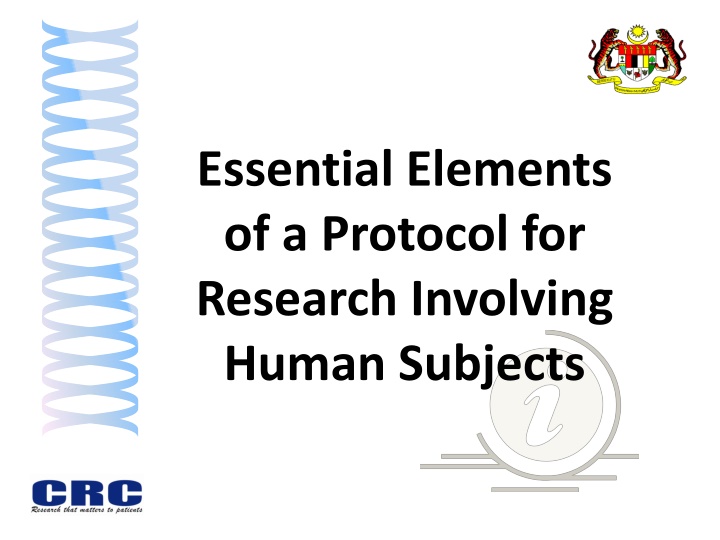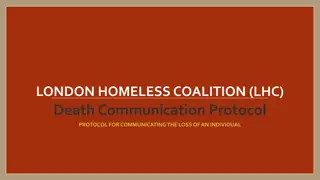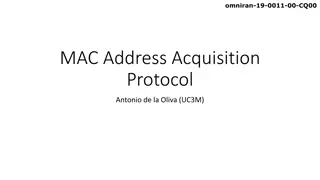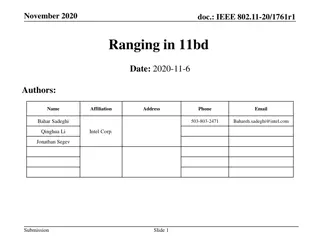
Key Elements of Ethical Research Protocol for Human Subjects
Ensure compliance with international ethical guidelines and include essential parts such as background, literature review, and ethical considerations in your research protocol for human subjects to enhance approval chances by reviewers.
Download Presentation

Please find below an Image/Link to download the presentation.
The content on the website is provided AS IS for your information and personal use only. It may not be sold, licensed, or shared on other websites without obtaining consent from the author. If you encounter any issues during the download, it is possible that the publisher has removed the file from their server.
You are allowed to download the files provided on this website for personal or commercial use, subject to the condition that they are used lawfully. All files are the property of their respective owners.
The content on the website is provided AS IS for your information and personal use only. It may not be sold, licensed, or shared on other websites without obtaining consent from the author.
E N D
Presentation Transcript
Essential Elements of a Protocol for Research Involving Human Subjects
DISCLAIMER The following information are the personal views of the presenter and do not represent the views or opinions of the Ministry of Health nor the National Clinical Research Centre
Acknowledgement to Dr Ho Tze Ming, for preparation of the core contents of this presentation
PURPOSE To educate participants on preparing research protocols that reviewers will likely approve
DEFINITION PROPOSAL: a document to support an application for approval from institution to conduct a study and obtain funding. PROTOCOL : a study s detailed methodology. A simplified protocol is usually part of a research proposal but is not detailed enough to qualify for ethical review.
REFERENCES ICH-GCP 1996 Part 6. Clinical Trial Protocol and Protocol Amendments. International Ethical Guidelines for Biomedical Research Involving Human Subjects, Council for International Organizations of Medical Sciences (CIOMS), Appendix 1: Items to be included in a protocol (or associated documents).
Essential Parts of a Protocol Title of study Must match objective(s). Investigator(s) and Sponsor Often missing. Name and institution (for investigator). Summary of study Often missing. Abstract of objective(s), design, methodology, sample size, study sites.
Essential Parts of a Protocol Background and Literature review What issue being addressed? How will findings of research address issue? Provide only relevant and current information Information must support issue to be addressed. Review relevant pre-clinical and clinical findings to support study procedures and specifications (e.g. treatment dosage, schedule, etc).
Essential Parts of a Protocol Ethical issues and considerations State international ethical guidelines are followed informed consent will be obtained (if applicable) Statement on any financial or other conflicts of interest that might affect the judgment of investigators. This is always missing from protocols reviewed by MREC.
Essential Parts of a Protocol Objective(s) General Specific (usually defines general objective) Must agree with title of study and methodology Study site/s brief description. Include rationale for selection. Target population Population that will benefit from study
Essential Parts of a Protocol Study population Specific population from which subjects shall be recruited. Number of subjects and how calculated. Be clear about variable and value used for calculation. Inclusion and exclusion criteria. State when, where and how informed consent / assent will be obtained.
Essential Parts of a Protocol Study design Case control, cohort, retrospective, prospective, etc. Randomization. How? Ratio of subjects in case and control? Blinding. Single / double. If no blinding, state how investigator bias is addressed. (e.g. blinded endpoint assessor) Include flow chart. Include schedule of visits and study procedures Duration of study Total duration of study. Expected duration of subject participation including follow-up
Essential Parts of a Protocol Study methodologies Interventions Justifications for dose, schedule, route, etc. Justify use of placebo, type of controls, or no treatment State efficacy endpoints clearly including how and when recorded. Methods of recording and reporting adverse events or reactions, and provisions for dealing with complications.
Study methodologies (cont) Interventions (cont) Plans and justification for withdrawing or withholding standard therapies in the course of the research, including any resulting risks to subjects. Any other treatment that may be given or permitted, or contraindicated, during the study. Criteria subjects may be removed from the study. If removed, will there be replacements? Criteria for terminating study.
Study methodologies (cont) clinical and laboratory tests. Provide info on the tests, who conducts, where done, specifications (including source, types of biomarkers, primers, etc). Quantity of biospecimens collected; how and when collected, by whom, how stored and for how long. What happens to excess / leftover specimens? Stored specimens will be used for future research? separate consent is required. If genomics are studied, state whether separate consent will be obtained and whether subjects will be informed of findings. State what happens to specimens if consent is withdrawn
Study methodologies (cont) Qualitative approaches (for population, public health, health systems research). State questionnaires used. Translated and verified? State how, when, where and by whom will interviews be conducted and recorded. Provide copy of questionnaire used for MREC to determine whether questions are appropriate. State what happens to data if subject withdraws consent.
Essential Parts of a Protocol Statistical methods Any interim analysis? By whom? What Stats software used? What statistical tests are used? Confidence level? Selection of data intent to treat, completed treatment, etc. How to deal with missing data?
Essential Parts of a Protocol informed consent How, where and when obtained? procedure planned to communicate information to prospective subjects. How to obtain for incompetent and vulnerable subjects? Provide justification if waiver of informed consent is requested. (Patient information sheet and consent are submitted separately)
Essential Parts of a Protocol Data forms and tables Samples of the standardized case-report forms to be used. Dummy tables. Questionnaires and survey forms (justify need for identifiable information). An account of any economic or other inducements or incentives to prospective subjects to participate.
Essential Parts of a Protocol Plans to inform subjects about the results of the study and follow-up activities. Confidentiality and security of personal info Who has access? Regulatory and IRB must be given access. How is access controlled? How secured? Data storage How long data is stored before destroyed.
Essential Parts of a Protocol Policy of dissemination of study findings How is confidentiality of personal information of human subjects maintained? in the case of an industrial sponsor, a contract stipulating who possesses the right to publish the results of the study and related conditions. Circumstances in which it might be considered inappropriate to publish findings. List of references
Protocol Amendments Minor (administrative) inform scientific and ethics committee. Major apply for scientific and ethical approval before implementation.
SUMMARY Participants have been informed of the essential elements in protocols that reviewers give attention to. Knowing that, participants should be able now to prepare protocols that will satisfy reviewers and facilitate approval.
TEMPLATES http://www.crc.gov.my/wp- content/uploads/documents/ProposalTemp late.pdf http://www.crc.gov.my/wp- content/uploads/documents/PROPOSAL%2 0TEMPLATE-observational%20study.pdf http://www.crc.gov.my/wp- content/uploads/documents/Check%20list %20for%20clinilcal%20trial%20protocol.pdf
Terima kasih






















